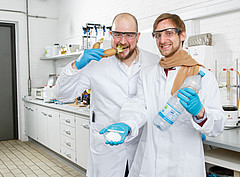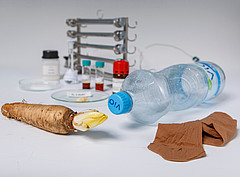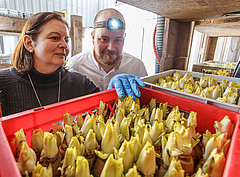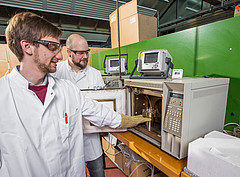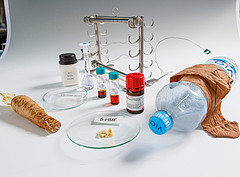Food & Raw Materials: Nylon stockings and plastic bottles made out of chicory salad waste [10.02.16]
Quality products made out of food production waste: Scientists at the University of Hohenheim extract basic chemicals for chemical industry from chicory root
800,000 tons: That’s how much waste in the form of chicory roots is generated during the production of chicory salad in Europe per year. Currently, after harvesting the chicory salad, the roots are disposed of in composting or biogas plants. What a waste, thought two researchers of the University of Hohenheim. Because these roots can be used to generate Hydroxymethylfurfural (HMF), a basic material in the future plastics industry.A windowless room in the experimental station of the Hohenheim campus. The walls are covered with 3-story shelfs holding numerous tubs lined with pond foil. The tubs contain plastic baskets in which the 15-20 cm long roots are placed upright. Over a period of 3 weeks, these roots grow into chicory buds ready to sell.
An aquarium pump waters the plants with a nutrient solution. The room is kept dark so the salad leaves do not lose their yellow pastel shade or develop any of the bitter substances typical for chicory.
The commercial production of chicory salad on the basis of water does not look much different – but a lot bigger: The biennial chicory plant only spends the first five months on the fields. In mid-October the leaves are mulched and the roots are harvested, stored in a cool place, and then brought to the growing rooms. Only there will the new buds, the future chicory salad, sprout.
But in contrast to the food production, at the University of Hohenheim the focus lies primarily on the non-edible root. “The root makes out approximately 30 % of the plant. The stored carbohydrates are not fully used for the formation of the buds and valuable reserve substances remain. However, the roots can only be used once for chicory growing and have to be thrown away after the buds are harvested”, explains agricultural biologist Dr. Judit Pfenning.
Nylon, polyester, perlon, or plastic bottles
In a laboratory of the Institute for Agricultural Engineering a few steps away, Prof. Dr. Andrea Kruse demonstrates just how valuable the root really is. In the background you can see pencil-high stainless steel tube reactors filled with chopped chicory roots and water.
After adding diluted acid into the ultra-stable pressure container, it is heated up to a temperature of 200 degrees. Afterwards, the watery product is processed in further steps, which are kept confidential.
At the end of this process their research associate Dominik Wüst looks at the result: unpurified hydroxymethylfurfural in the form of yellow-brown crystalline powder. This is one of the 12 basic chemicals which will in the future be used in the plastic industry. It serves as a raw material for nylon, perlon, polyester, or plastic bottles – so-called PEF-bottles, not the PET-bottles. On the wholesale market, it is currently worth 2000 euros per kilo.
Chicory-made HMF as part of bioeconomy
So far, such chemicals are obtained from crude oil. The field of bioeconomy is concerned with the question of how they can be produced in a sustainable way. Bioeconomy focusses on plants, animals, or microorganisms as sources for energy instead of fossil raw materials.
As part of a previous research project Prof. Dr. Kruse already found a way to extract the basic chemical HMF from fructose. However, she is of the opinion that chicory roots as a source are more elegant. After all: “Fructose is edible. There are better uses for it than extracting HMF.” This is not the case for chicory roots. “Until now, they were waste.”
The challenge: storage and quality of the roots
The project poses a challenge: “The root is only of interest for the industry if we can guarantee permanent quality,” explains Prof. Dr. Kruse.
To this end, the technical chemist cooperates with the plant scientist Dr. Judit Penning from the Department of General Crop Farming. “In general, the conditions are very good,” explains Penning, “because the consumer who wants to eat the chicory also has very high and consistent quality expectations. That is why only roots of very high quality are transferred from the fields into the commercial growing rooms operating with water-forcing techniques.”
Another research aspect: How the roots can be stored without going bad. The problem is that chicory is a seasonal business. However, suppliers of the chemical industry want permanent deliveries in order to be able to constantly use their plants.
“This project can only be carried out through interdisciplinary cooperation,” emphasize the scientists. One the one hand the project includes quality control, growing trials, and storage experiments, and on the other hand laboratory experiments and conversion technology.
HMF based on chicory is of higher quality than the chemical made of crude oil
Additionally, another aspect makes the project even more likely to be successful: “The chicory root is not only perfectly suited for the production of HMF because it is waste,” says Prof. Dr. Kruse. “It also produces a chemical of higher value than the crude oil-equivalent.”
This means that PEF-bottles made out of chicory-HMF could for example be thinner than bottles made out of crude oil-PET. This in turn saves money for transportation and further improves the environmental performance.
A part of the great amount of chicory roots is nowadays used for the production of biogas. But this use of the chicory root is economically speaking inferior: “Approximately 220,000 roots per hectare could theoretically amount to 8.14 tons of inulin. Which, according to current research, can be made into 2.87 tons of HMF. Selling this product could make 5.74 million euros. Electricity from biogas produced from this amount of roots would, according to the EEG, only amount to around 21,000 euros.”
Text: C. Schmid / Klebs
Contact for press:
Prof. Dr. Andrea Kruse, University of Hohenheim, Conversion Technology and Life Cycle Assessment of Renewable Resources
+49711 459 24700
Andrea_Kruse@uni-hohenheim.de
Dr. sc. agr. Judit Pfenning, University of Hohenheim, Agronomy
+49711 459 22356
pfenning@uni-hohenheim.de
Back to

